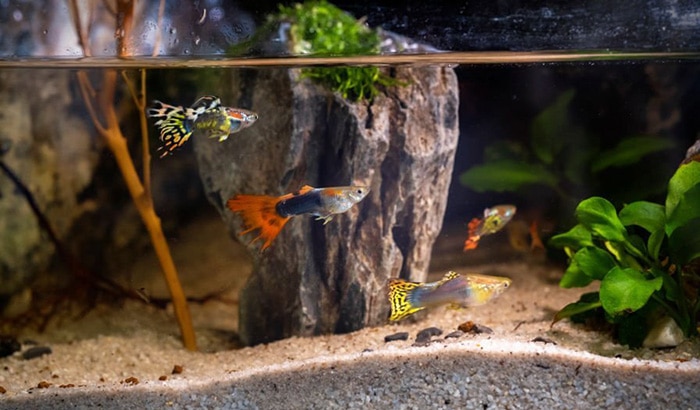Guppies are a favorite among freshwater aquarium enthusiasts, renowned for their ease of care and suitability for beginners. They stand out in the aquatic community for their vibrant colors and dynamic personalities.
Our “Guppy Care Guide” is designed to provide you with all the essential knowledge for maintaining a thriving guppy habitat. Although guppies are relatively simple to care for, understanding their fundamental needs is crucial for ensuring their longevity and well-being. Dive into this guide to learn how to create the perfect environment for your guppies to flourish!
Introduction to Guppy
Guppies, with the scientific name Poecilia reticulata, are a beloved addition to many freshwater aquariums around the globe. Originally from the northeastern regions of South America, these small yet vibrant fish have gained international popularity due to their remarkable adaptability and straightforward care requirements.
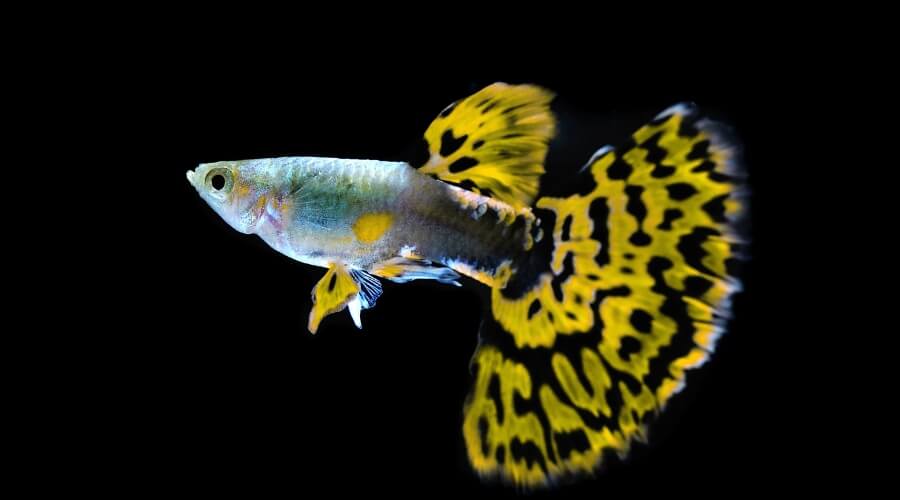
The males, in particular, are known for their dazzling array of colors and intricate patterns, outshining the more subdued females. Beyond their aesthetic appeal, guppies have also garnered attention in the scientific community, serving as a key species for studies on reproductive systems and genetic diversity.
In the wild, guppies are found in calm and shallow waters, where they feed on a diverse diet that includes both plant matter like algae and small aquatic creatures. Their resilience and lively nature make them a top choice for aquarium enthusiasts of all levels, from beginners to seasoned experts.
Guppy Appearance and Characteristics
Guppies are renowned for their vivid hues and are a favorite among aquarium enthusiasts. These livebearers belong to the Poeciliidae family and are a common choice for domestic aquariums due to their striking color variety.
Appearance:
- Wild Guppies: Typically, wild guppies have a muted grey coloration in their natural environments, but males can exhibit some color patterns such as spots and stripes.
- Aquarium Guppies: Selective breeding has led to a spectrum of brilliant colors and elaborate fin designs in aquarium guppies. Colors range from red to orange, and fins are often elongated and ornate.
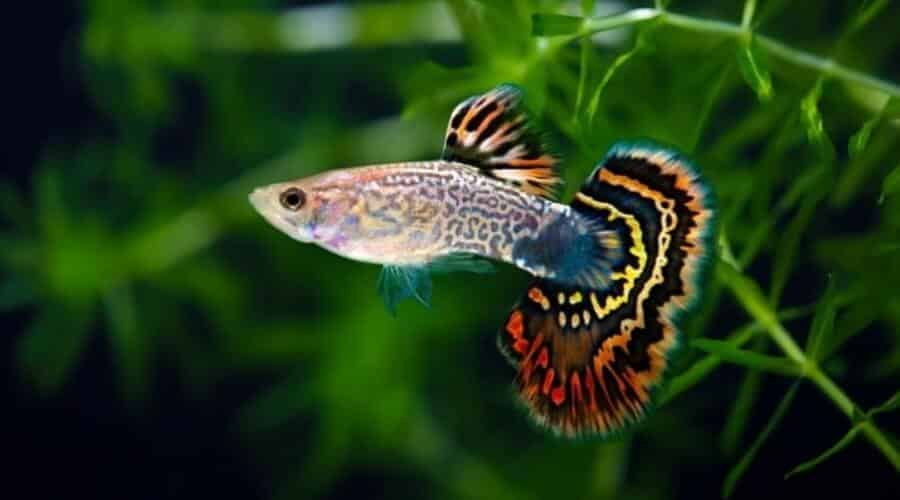
Characteristics:
- Resilient and Active: Guppies are adaptable and lively, which makes them suitable for both beginners and seasoned fish keepers.
- Social Nature: They thrive in groups and the size of their schools can fluctuate based on predator presence, with larger schools forming in more dangerous environments.
- Adaptive Reproduction: Guppies can adjust their breeding frequency in response to food availability, optimizing their reproductive efforts for times when offspring are more likely to survive.
Understanding Guppy Lifespan
Guppies, celebrated for their dazzling array of colors and low-maintenance nature, typically enjoy a lifespan of 2-3 years when kept in home aquariums. With exceptional care, which includes a balanced diet, pristine water conditions, and a tranquil habitat, it’s possible for some guppies to reach an age of up to 5 years.
In their natural environment, guppies face various challenges that can impact their longevity, such as predators, fluctuating food sources, and environmental conditions. As a result, wild guppies often have a shorter life expectancy, averaging around 2 years. The Fancy Guppy, a variant highly sought after by fish enthusiasts, is noted for its potential to live up to 5 years in an optimally managed aquarium setting.
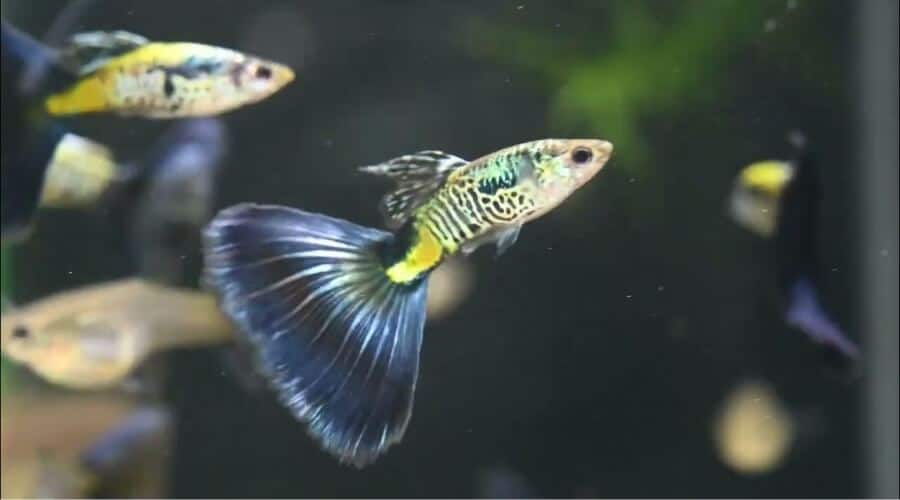
Genetic factors also influence the lifespan of guppies. Certain genetic traits can enhance their resistance to illness and stress, leading to a longer lifespan. On the flip side, some guppies may inherit traits that predispose them to health complications, which could shorten their life expectancy.
Determining the Average Size of Guppies
Guppies, a popular species in the aquarium trade, exhibit size differences between genders. Male guppies typically reach lengths of 0.6–1.4 inches, while female guppies are generally larger, measuring 1.2–2.4 inches. Selective breeding can result in larger guppies, with some individuals growing up to 2.5-3 inches, though this is rarer in domestic aquariums.
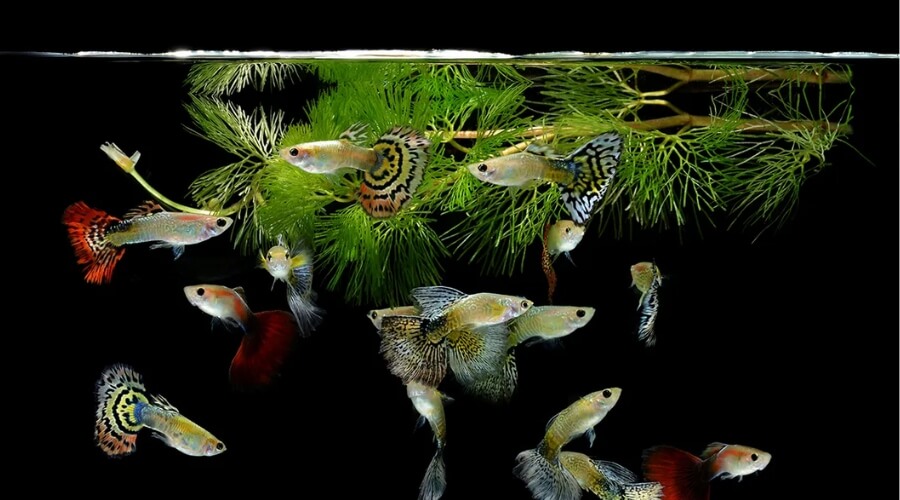
By 6 months of age, guppies are expected to attain their full size, although fin growth may persist beyond this point. The growth rate of guppies is subject to genetic, dietary, and environmental influences. Ensuring optimal care, including a nutritious diet and high-quality water conditions, is crucial for guppies to achieve their maximum size potential.
Essential Guppy Care Practices
Guppies are often suggested to beginner aquarists for good reason. Despite their diminutive stature, they are remarkably robust!
These fish are known for their resilience and adaptability, making them an excellent option for those new to the aquarium hobby. The care requirements for guppies are manageable for most people.
However, like any species, guppies do have specific care preferences and needs that must be met for them to flourish. Here is the essential information that is key to their care.
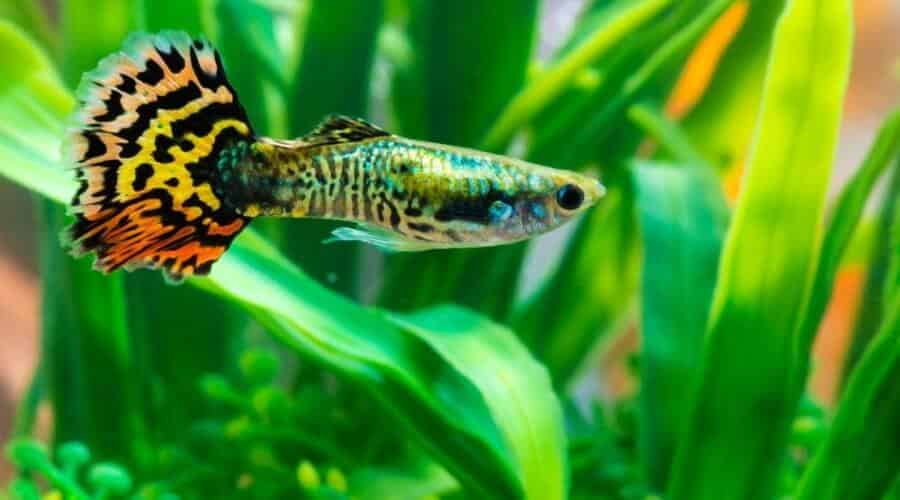
Ideal Tank Size for Guppies
The ideal tank size for guppies is at least 10 gallons for a small group. This provides enough space for swimming and reduces stress, which can lead to a healthier life. For larger groups or breeding purposes, a 20-gallon tank or larger is recommended.
Maintaining Optimal Water Parameters
Guppies thrive in water with a temperature range of 72-82°F (22-28°C), a pH level of 6.8-7.8, and hardness between 8-12 dGH. Regular water changes and monitoring are crucial to maintain these parameters.
Essential Items for a Guppy’s Tank
A well-set-up guppy tank should include:
- A filtration system to keep the water clean.
- A heater to maintain a stable temperature.
- Live plants and decorations to provide hiding spaces and reduce stress.
- A lighting system to simulate a natural day-night cycle.
Addressing Common Guppy Diseases and Health Issues
Common diseases affecting guppies include fin rot, ich (white spot disease), and fungal infections. To prevent these, maintain good water quality, avoid overcrowding, and quarantine new fish before adding them to the tank. If diseases occur, treat promptly with appropriate medications and improve tank conditions to prevent recurrence.
Nutritional Needs: Guppy Food and Diet
For guppies to thrive, a balanced diet comprising proteins, carbohydrates, and fats is crucial. Juvenile guppies require approximately 60% protein for growth, while adults need about 45%. Carbohydrates, which should make up 15% of their diet, are vital for energy, and fats, important for cellular functions and reproduction, should constitute 10-15%.
Vitamins and Minerals:
- Vitamin A: Essential for healthy vision and growth.
- Vitamin C: Strengthens the immune system.
- Vitamin E: Crucial for reproductive health and cell membrane protection.
- Niacin: Necessary for efficient metabolism and energy generation.
- Calcium: Plays a key role in the development of bones and scales.
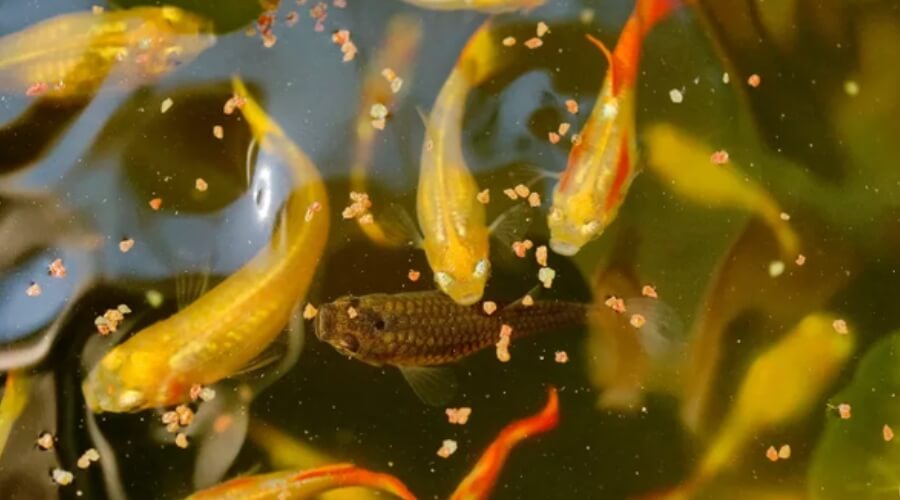
Food Varieties:
- Commercial Food: Flake or pellet foods of high quality can satisfy most of the guppies’ nutritional needs.
- Live Foods: Foods like brine shrimp, daphnia, and bloodworms contribute significantly to growth and pigmentation.
- Frozen Foods: These offer a practical substitute for live foods and provide comparable nutritional value.
Feeding Guidelines:
- It’s best to feed guppies small portions several times daily, which aligns with their natural foraging habits.
- Overfeeding should be avoided to prevent health complications such as bloating and swim bladder disorders.
Selecting Compatible Tank Mates for Guppies
When selecting tank mates for guppies, it’s important to consider factors such as size compatibility, temperament, water parameters, dietary needs, and swimming zone preferences to ensure a harmonious aquarium environment. Here are some compatible tank mates for guppies:
- Corydoras Catfish
- Neon Tetras
- Swordtails
- Platies
- Mollies
- Honey Gouramis
- Cardinal Tetras
- Harlequin Rasboras
- Otocinclus Catfish:
- Nerite Snails
- Bristlenose Plecos
- Kuhli Loaches
- Siamese Algae Eater
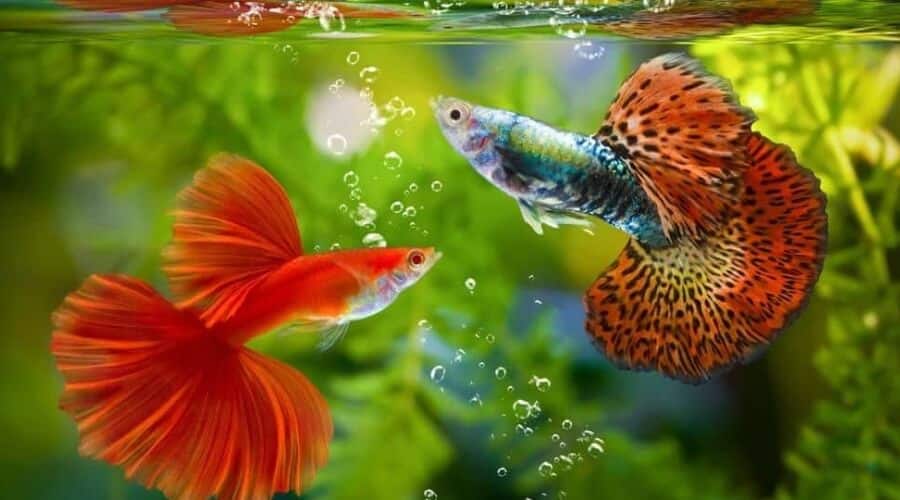
Essential Steps in Guppy Breeding
Breeding guppies offers a fulfilling venture for those passionate about aquariums. Below is a comprehensive guide to breeding guppies:
Selecting Breeding Pairs
Opt for robust male and female guppies that display preferred attributes like coloration and fin configurations. To avoid undue stress on females, a typical ratio is one male for every two to three females.
Breeding Tank Preparation
Set up a breeding tank ranging from 10 to 20 gallons, equipped with a heater and a gentle filtration system to safeguard the fry from being drawn into the filter. Include ample hiding spots, such as floating plants, for the fry to take refuge post-birth.
Water Conditions
Keep the water temperature within 77-80°F (25-26.66°C) and uphold high water quality to encourage healthy breeding. Prior to transferring them to the breeding tank, nourish the guppies with food rich in nutrients.
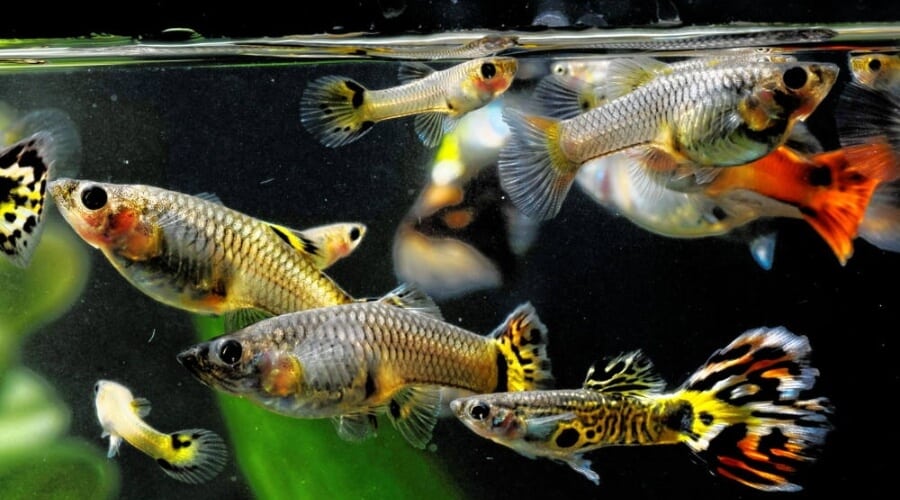
Mating Behavior
Male guppies engage in elaborate displays of color and fin movement to woo females. Upon a female’s acceptance, the male will internally fertilize her with his gonopodium.
Fry Care
Post-delivery, furnish the fry with numerous hiding places and feed them specialized fry food or finely ground flake food. Conduct frequent water changes to preserve a clean environment and minimize disease risks.
Growth and Segregation
As the fry mature, segregate them based on size to prevent cannibalism among the larger fry. This separation also facilitates closer observation of their growth.
Selective Breeding
For those targeting specific traits, selectively breed guppies that manifest those qualities. This practice can yield new varieties distinguished by their unique color patterns and fin shapes.
Conclusion: Mastering Guppy Care
In conclusion, proper Guppy Care is essential for maintaining a vibrant and healthy aquarium. These small, colorful fish are a joy to observe and their resilience makes them perfect for aquarists of all levels. Adhering to the Guppy Care guidelines ensures that your guppies will thrive, adding a dynamic and lively presence to your aquatic setup. A balanced diet, ideal tank conditions, and consistent upkeep are the pillars of successful Guppy Care, guaranteeing the well-being of these charming creatures.
For more insightful and valuable information on guppy care and other aquatic wonders, be sure to follow Nationalpark Aquarium. Stay updated with the latest tips, tricks, and facts that will help you become a more informed and successful aquarist.

